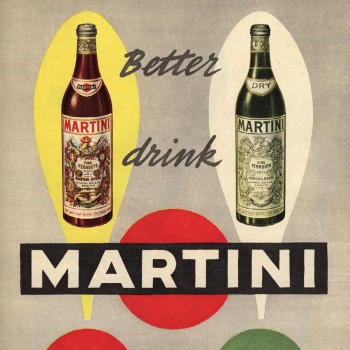While old-school martini-swillers might see vermouth as little more than a flavoring interfering with the purity of their precious gin, a new generation of American distillers is reinvigorating the fortified wine. Whipping up small batches with inventive recipes, some refreshing enough to be sipped on their own as an aperitif, vermouth is making a comeback.
New York Magazine published an article on the trend this week, so Brendan — a champion of the dry martini — grudgingly paid a visit to their food editor, Alan Sytsma, not least of all to ask… “Why did you do this to me?!”

Alan Sytsma: I don’t know what to tell you. I mean, people have taken vermouth and made it — as they have with everything — artisanal. So the market is flooded with handmade, handcrafted high-quality vermouth.
You know, it’s very “Continental” to start your meal with an aperitif, something a little lighter. It’s stronger than wine, they’re usually around like 15-18% alcohol, but they’re not gonna knock you out the way a martini does before the meal.So people are kind of embracing that.
Brendan Francis Newnam: All right, well in the interest of knowing thine enemy, I bought a couple European vermouths and a couple bottles of this new-look vermouth from America. So let’s start here with… I bought Dolin French dry vermouth.
Alan Sytsma: French dry vermouth is the vermouth that martini drinkers ignore when they’re talking about dry martinis. This is it. It’s really light, it’s clear, it’s basic. It is at a certain level just a mixer. I don’t know if I would really suggest doing this straight, but we’re gonna do it anyway.
Brendan Francis Newnam: Well let’s just taste it. If we decide we don’t like it, this will prove my point.
Alan Sytsma: Well, not yet, because we’ve only just begun.
Brendan Francis Newnam: Well… let’s just take a little sip here.
Alan Sytsma: All right, well cheers.
Brendan Francis Newnam: Cheers.
This does taste like the thing, if there’s too much of in my martini, it makes me sad.
Alan Sytsma: It’s syrupy; it’s a little bitter, not really. I mean it tastes like what it is, which was originally just a way to save wine that was gonna spoil.
Brendan Francis Newnam: So is that where vermouth came from?
Alan Sytsma: That’s one of the rumors anyway, one of the stories, but yeah — I mean, that’s what it is. It’s wine, stuff has been added to it, it’s been spiked with a neutral spirit like a vodka kind of a thing. They use grape spirits often. And so that’s what it is- it’s wine that’s just been made a little bit stronger and a little bit more resilient through the use of all these botanicals.
Brendan Francis Newnam: All right. Well, this is not an unfamiliar taste, and it’s pretty inoffensive. It’s just pretty much… meh.
Alan Sytsma: Yeah, it’s like the 7up of the vermouth world.
Brendan Francis Newnam: All right so let’s move on. And this is another classic: This is sweet vermouth, sweet Italian vermouth.
Alan Sytsma: Carpano Antica, which I have no Italian verve in the way I say it, but yeah, that’s what it is. Sweet vermouth is typically associated with Italy, even though French people make both, Italian people make both, Americans make all kinds. But it is the style that people think of first, and it was the first kind of vermouth. And this is what people, in America anyway, are adding to their Manhattans.
Brendan Francis Newnam: This is a much darker vermouth. It’s a red vermouth. And… It smells a little bit like olives. Am I crazy?
Alan Sytsma: No, I mean there’s a lot of nuttiness in it. You know these things… the aromatics they keep secret. These are the kinds of recipes that have been held onto for hundreds of generations.
A monk invented them at some point and now everybody is very secretive about what they put in there.
Brendan Francis Newnam: Yet another reason we can’t trust vermouth.
Alan Sytsma: Live with a little mystery in your life. It’s okay.
Brendan Francis Newnam: All right, let’s taste this.
Now this is much, much sweeter… and maybe a little bit of licorice in there?
Alan Sytsma: Yeah, it’s a lot more amped up. I mean it’s not gentle, it’s not neutral, it’s sweeter, but then it’s also a lot more bitter at the end.
Brendan Francis Newnam: Moving on to the American vermouths, let’s check out this Massican vermouth from California, which… this looks just like a very tall bottle of Pinot Grigio. And it smells really lemony.
Alan Sytsma: It’s so different than the other ones, just so many more aromatics. It’s really fresh, it’s really floral.
Brendan Francis Newnam: Wow. It is almost, dare I say… it tastes like a cleaning supply.
Alan Sytsma: It’s strong. It’s definitely strong, and especially compared to the other ones. This one, you know, we’re not drinking it with ice. I would recommend it, it’s gonna soften it a lot.
Brendan Francis Newnam: All right, so let’s try this last one, and this is called Uncouth Vermouth. It’s made in Brooklyn in what else, small batches.
Alan Sytsma: I mean just looking at the bottle you know it’s either made in Brooklyn, Portland, Oregon, or possibly Austin, Texas. Those are the only three possible places it could come from. You know, it has that kind of Moulin Rouge sort of vibe to it, but definitely the rough, hand-worn kind of aesthetic is going on as well.
Brendan Francis Newnam: And also the other thing that gives it away is: this is vermouth, yet on the bottom left corner it says “pear ginger.”
Alan Sytsma: Well what you’re seeing from a lot of these American vermouth makers is that they’re really breaking away from the basic dry or sweet. They’re doing all sorts of weird, weird flavors, as evidenced by the name.
Brendan Francis Newnam: Let’s give this a shot. It is a ginger color in keeping with the flavor.
It sure tastes like ginger! I guess there’s pear in there.
Alan Sytsma: It’s “ginger-forward” you might say, and then it kind of drops off, like it doesn’t really follow a lot. But that’s the other thing, where it’s not lingering, you know, it’s just sort of disappearing and getting you ready to move on to a bottle of wine.
So you know, it’s something different. I don’t think that there’s any reason for people to kind of pigeon hole into “I’ve gotta have a cocktail” or “I’ve gotta have beer and wine.” There’s a lot more going on, and this is just kind of another example.
Brendan Francis Newnam: So the dry martini is not under threat, it’s safe.
Alan Sytsma: I think they’ll probably be around for a little while longer, yeah, I don’t think they’re going anywhere. But you can have this as an alternative.


